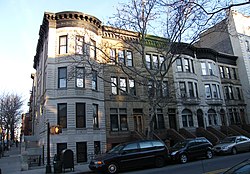Sugar Hill, Manhattan
Sugar Hill Historic District | |
 Sugar Hill Historic District, March 2009 | |
| Location | Roughly bounded by W. 155th St., 145th St., Bradhurst Ave. and Convent Ave., New York, New York |
|---|---|
| Area | 75 acres (30 ha) |
| Built | 1865 |
| Architect | Andersen, Henry; et.al. |
| Architectural style | Queen Anne, Classical Revival |
| NRHP reference No. | 02000360 [1] |
| Added to NRHP | April 11, 2002 |
Sugar Hill is a neighborhood in the northern part of Hamilton Heights, which itself is a sub-neighborhood of Harlem, a neighborhood in the New York City borough of Manhattan.[2] The neighborhood is defined by 155th Street to the north, 145th Street to the south, Edgecombe Avenue to the east, and Amsterdam Avenue to the west.[3] The name originated in the 1920s, when the area became a popular place to live for wealthy African Americans.
Named to identify the "sweet life" in Harlem, it was a popular residential area of rowhouses for wealthy African Americans during the Harlem Renaissance, including W. E. B. Du Bois, Thurgood Marshall, Adam Clayton Powell Jr., and Duke Ellington. Langston Hughes wrote about its relative affluence in relation to Harlem in his essay "Down and Under in Harlem" published in The New Republic in 1944.[4]
Sugar Hill was made a municipal historic district by the New York City Landmarks Preservation Commission in 2000.[5] It was listed on the National Register of Historic Places in 2002.[1] The Sugar Hill Historic District has 414 contributing buildings, two contributing sites, three contributing structures, and one contributing object.[6]
Rap group The Sugarhill Gang and rap record label Sugar Hill Records pay homage to the neighborhood in their names.[citation needed]
Sugar Hill is mentioned in the lyrics to the jazz standard "Take the A Train" by Billy Strayhorn. It is also referred to by rapper AZ's "Sugar Hill" on his album Doe or Die.
Notes
- ^ a b "National Register Information System". National Register of Historic Places. National Park Service. March 13, 2009.
- ^ "Harlem - New York City Neighborhood - NYC". nymag.com. New York Magazine. 2003-03-10. Retrieved 2009-01-04.
- ^ "Harlem, Hamilton Heights, El Barrio, New York City". ny.com. Retrieved 2009-01-04.
- ^ "If you are white and are reading this vignette, don't take it for granted that all Harlem is a slum. It isn't. There are big apartment houses up on the hill, Sugar Hill, and up by City College -- nice high-rent-houses with elevators and doormen, where Canada Lee lives, and W. C. Handy, and the George S. Schuylers, and the Walter Whites, where colored families send their babies to private kindergartens and their youngsters to Ethical Culture School."
-- from "Down Under in Harlem" by Langston Hughes, The New Republic (March 27, 1944): 404-5 - ^ Siegal, Nina (2000-06-15). "Landmark Status For Harlem Buildings; District Holds Hub of Black Culture". The New York Times. The New York Times Company. Retrieved 2009-01-04.
- ^ Kathleen A. Howe (January 2002). "National Register of Historic Places Registration: Sugar Hill Historic District". New York State Office of Parks, Recreation and Historic Preservation. Retrieved 2011-03-25. See also: "Accompanying 69 photos".
External links
- "Hamilton Heights - West Harlem". westharlemcpo.org. Hamilton Heights - West Harlem Community Preservation Organization. Retrieved 2009-01-04.



